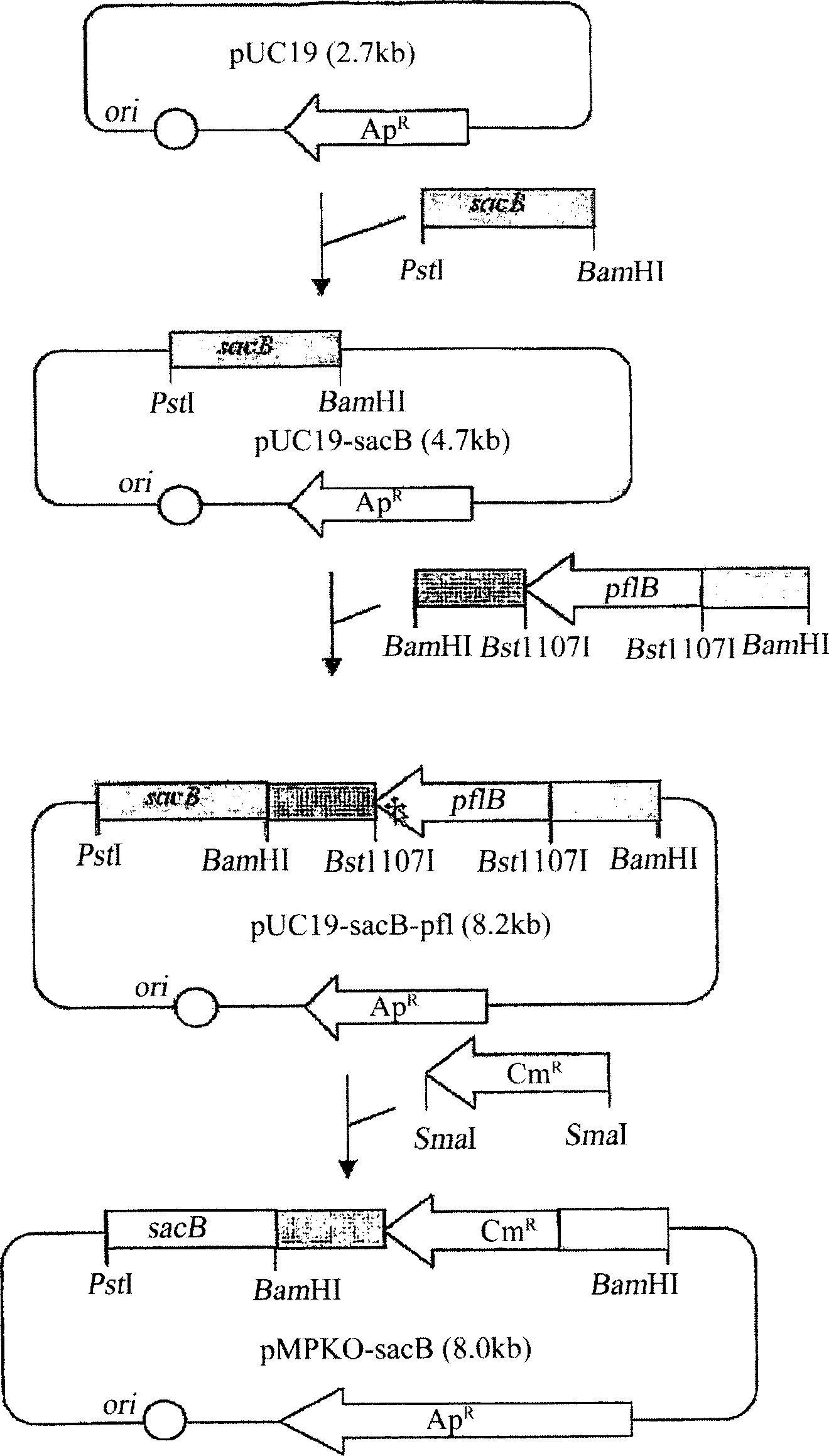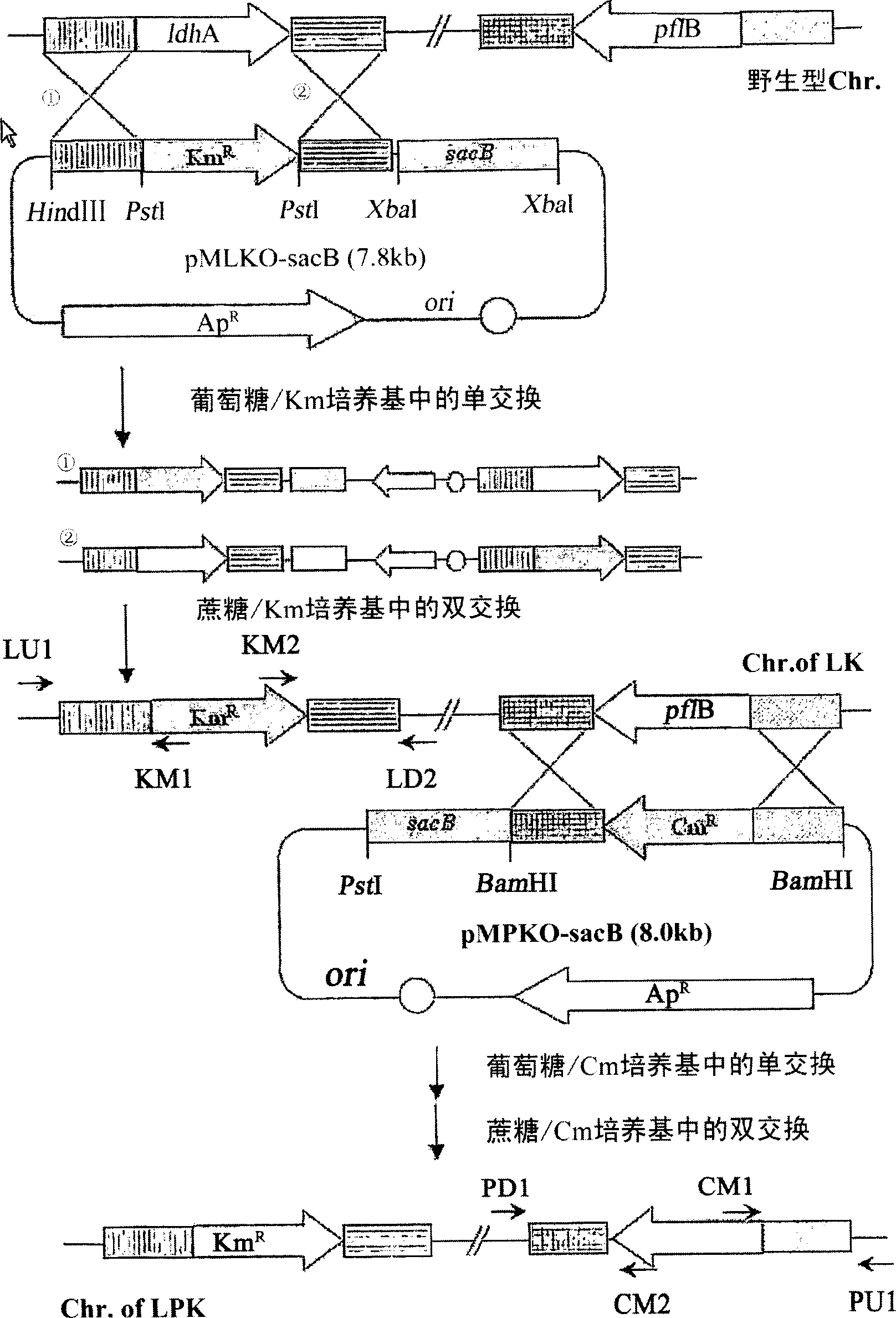Novel rumen bacteria variants and process for preparing succinic acid employing the same
A technology of mutant and succinic acid, applied in the field of producing succinic acid, can solve the problems of not reaching industrial application, low yield of organic acid or succinic acid, etc.
- Summary
- Abstract
- Description
- Claims
- Application Information
AI Technical Summary
Problems solved by technology
Method used
Image
Examples
Embodiment 1
[0043] Example 1: Construction of pMLKO-sacB
[0044] In order to disrupt the lactate dehydrogenase gene (ldhA) by homologous recombination, a gene exchange vector can be constructed as follows. First, use the genomic DNA of Mannheimia succiniciproducens 55E (KCTC 0769BP) as a template, and perform PCR with the primers listed in the following SEQ ID NO: 1 and SEQ ID NO: 2, and then digest the resulting PCR fragment with SacI and PstI , and introduced into pUC18 (New England Biolabs, Inc., Beverly, Mass.), thereby constructing pUC18-L1.
[0045] SEQ ID NO: 1: 5'-CAGTGAAGGAGCTCCGTAACGCATCCGCCG (LS1)
[0046] SEQ ID NO: 2: 5'-CTTTATCGAATCTGCAGGCGGTTTCCAAAAA (LP1)
[0047] Afterwards, using the genomic DNA of Mannheimia succiniciproducens 55E as a template, PCR was performed with the primers listed in the following SEQ ID NO: 3 and SEQ ID NO: 4, and then, the obtained PCR fragment was digested with PstI and HindIII, and introduced into pUC18 -L1, thereby constructing pUC18-L1-L...
Embodiment 2
[0055] Example 2: Construction of pMPKO-sacB
[0056] To fragment the pyruvate formate lyase gene (pfl) by homologous recombination, a gene exchange vector can be constructed as follows. The pKmobsacB template containing the sacB gene (Genbank 02730) was subjected to PCR with the primers listed in SEQ ID NO:8 and SEQ ID NO:9 below. The resulting sacB product was digested with PstI and BamHI and introduced into pUC19 (Stratagene Cloning System. La Jolla, Calif.) to construct pUC19-sacB.
[0057] SEQ ID NO: 8: 5'-AGCGGATCCCCTTCTATCGCCTTCTTGACG(SBG)
[0058] SEQ ID NO: 9: 5'-GTCCTGCAGGGCTACAAAATCACGGGCGTC (SPR)
[0059] Using the genomic DNA of Mannheimia succiniciproducens 55E as a template, PCR was performed with the primers listed in SEQ ID NO: 10 and SEQ ID NO: 11 below. The resulting PCR fragment was digested with BamHI and fused with pUC19-sacB digested with BamHI to construct pUC19-sacB-pfl.
[0060] SEQ ID NO: 10: 5'-CATGGCGGATCCAGGTACGCTGATTTCGAT (PB1)
[0061] SEQ ...
Embodiment 3
[0065] Embodiment 3: Construction of Mannheimia sp.LPK bacterial strain
[0066]Figure 3 shows the process of constructing a mutant strain (LPK) by breaking the ldhA and pfl genes from Mannheimia succiniciproducens 55E. Mannheimia succiniciproducens 55E was poured onto LB-glucose medium containing 10 g / l glucose and incubated at 37°C for 36 hours. The formed colonies were inoculated in 10 ml of LB-glucose liquid medium and cultured for 12 hours. Inoculate 1% of the fully grown culture solution into 100 ml LB-glucose liquid medium, and culture in a shaking incubator at 200 rpm and 37°C.
[0067] After 4-5 hours, when the OD value of the culture solution reached about 0.2-0.3, the cells were collected by centrifugation at 4000 rpm for 10 minutes at 4°C. Afterwards, the cells were resuspended in 200 ml of 10% glycerol solution at 4°C. The suspension was centrifuged at 4000 rpm for 10 minutes at 4°C to collect the cells, and resuspended in 200 ml of 10% glycerol solution at 4°C...
PUM
 Login to View More
Login to View More Abstract
Description
Claims
Application Information
 Login to View More
Login to View More - R&D
- Intellectual Property
- Life Sciences
- Materials
- Tech Scout
- Unparalleled Data Quality
- Higher Quality Content
- 60% Fewer Hallucinations
Browse by: Latest US Patents, China's latest patents, Technical Efficacy Thesaurus, Application Domain, Technology Topic, Popular Technical Reports.
© 2025 PatSnap. All rights reserved.Legal|Privacy policy|Modern Slavery Act Transparency Statement|Sitemap|About US| Contact US: help@patsnap.com



